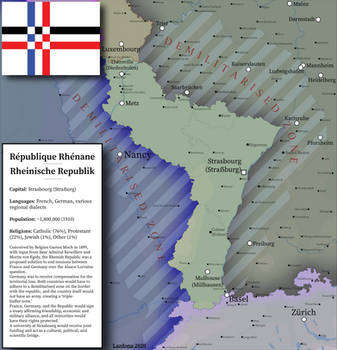Deviation Actions
Badge Awards
Description
Map of the Republic of Austria in 2016. Few things went differently in this timeline, where the outcomes were more favorable for Austria.
Throughout the 19th century under the Habsburg Monarchy, strict nationalistic laws promote the use of the German language, while heavily restricting minority ones. By the time of the first world war, there are significant populations of Austrians in Carniola, Littoral and West Hungary. The empire, prior, had greatly prepared for the chance of a war; it didn't want to lose investments and valuable industries, especially on the Adriatic coast. During the first world war, the government manages to defend and maintain control of Carniola, Littoral, most of southern Tirol, and its navy presence in the Adriatic Sea from Italian, Yugoslav, and French forces. Austrian forces never take offence into Italy, deeming it too risky, and instead focus on defence using the mountainous geography as an advantage.
At the conclusion of the war in early 1919, the treaty of St. Germain ordered that Austria give up territories that had Austrian populations, and thus the Austrian government refused to accept the terms. After a stalemate and a long freeze in negotiations, the Allied negotiators decide to compromise with the Austrians: they were allowed to keep the German speaking parts of southern Tirol, as well as access to the coast. In exchange for these territories, Austria must become a republic and is forbidden to union with Germany. Additional developments allowed the keeping of a strip of land in the south of Bohemia and Moravia, but also significant gains in western Hungary which has had significant German influence. Despite the calls form Pan-Slavists and the Slovene national movement, the Slovenes did not manage to achieve having a say in the negotiations, any spearheads for the moment came too late and the movement was too disorganised. This left the Slovene populations to remain within the newly formed Austrian Republic. All, of these conditions, of course, were much to the displeasure of the Italian, Yugoslav, Czeh, and Hungarian governments. During The second world war, the republic was incorporated into the Third Reich, but upon its conclusion, statehood was restored.
Today, Austria is a parliamentary representative democracy comprising eleven federal states (including the federal capital). The capital and largest city, with a population of 2.2 million, is Vienna. Austria is one of the richest countries in the world, with a nominal per capita GDP of $49,345. The country has developed a high standard of living and in 2014 was ranked 21st in the world for its Human Development Index. Austria has been a member of the United Nations since 1955, joined the European Union in 1995, and is a founder of the OECD. Austria also signed the Schengen Agreement in 1995, and adopted the euro currency in 1999. Recognised regional ethnic minorities include: Slovenes, Hungarians, Italians, Croatians, and Slovakians.
Feel free to comment and suggest what you think of this version of Austria. I would also like to know what I did well and what I need to improve on. Thanks!
The border between Bozen and Trient should be moved a bit south, closer to Trient than to Bozen:

























![[AGGT] Division of Hungary (1900)](https://images-wixmp-ed30a86b8c4ca887773594c2.wixmp.com/f/1164ffd5-7a08-466e-bb07-0e8165e71bd1/ddljfn5-dd452bc2-a9d1-4ddd-a32f-df1c2d07ca62.png/v1/crop/w_184)










